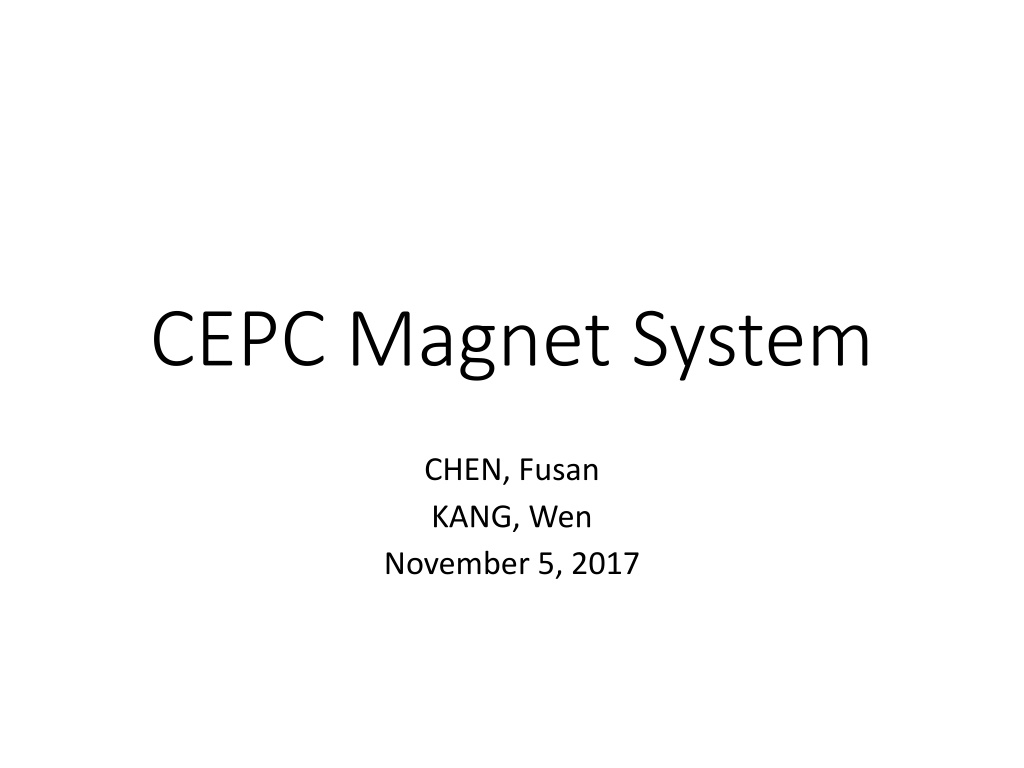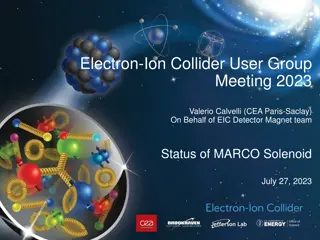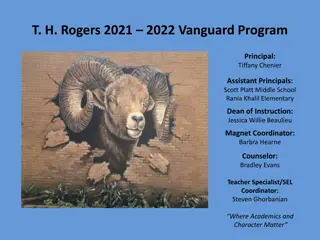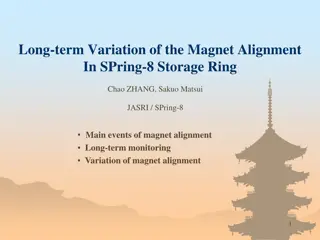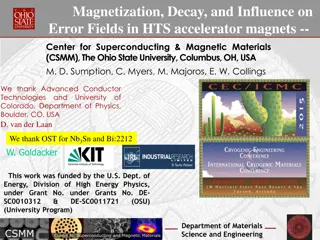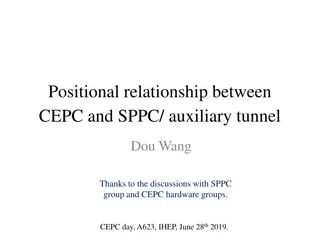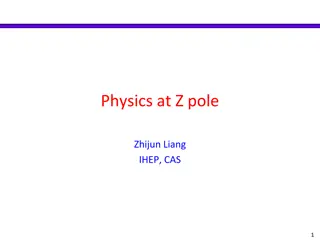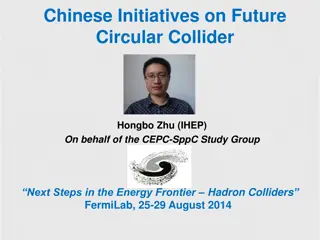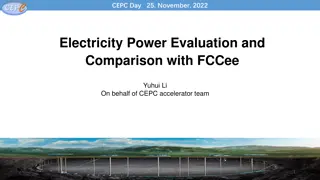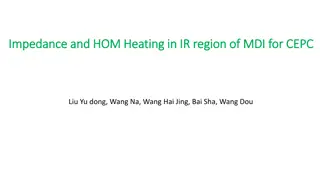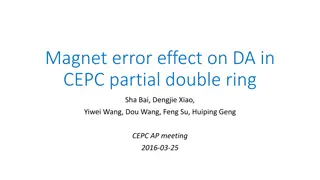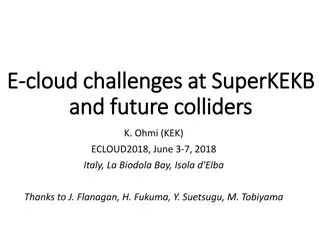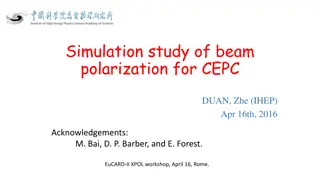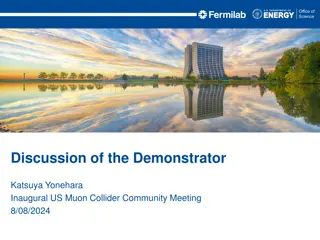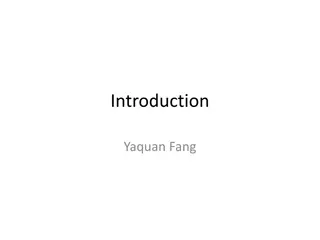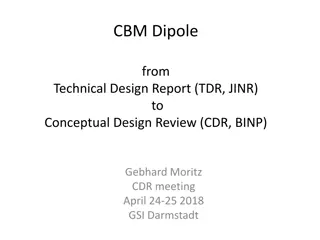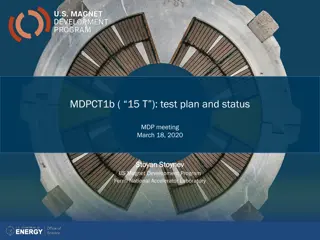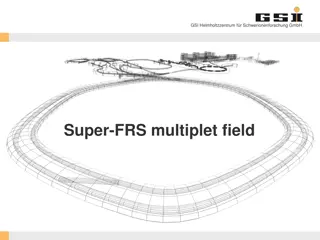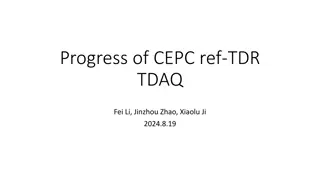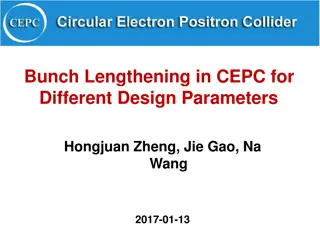CEPC Collider Magnet System Overview
The CEPC collider magnet system comprises dual aperture dipole, dual aperture quadrupole, sextupole, and booster magnet designs. These magnets cover a significant portion of the 100km ring, addressing considerations such as manufacturing cost, power consumption, and field quality. The design focuses on reducing costs and power consumption while optimizing magnet performance. Specific strategies include using aluminum coils, reducing core filling factors, and exploring high-voltage low-current designs. The dual aperture dipole design involves segmenting the core and combining different polarity sextupoles to enhance efficiency. Overall, the system aims to achieve a balance between performance, cost, and energy efficiency.
Download Presentation

Please find below an Image/Link to download the presentation.
The content on the website is provided AS IS for your information and personal use only. It may not be sold, licensed, or shared on other websites without obtaining consent from the author.If you encounter any issues during the download, it is possible that the publisher has removed the file from their server.
You are allowed to download the files provided on this website for personal or commercial use, subject to the condition that they are used lawfully. All files are the property of their respective owners.
The content on the website is provided AS IS for your information and personal use only. It may not be sold, licensed, or shared on other websites without obtaining consent from the author.
E N D
Presentation Transcript
CEPC Magnet System CHEN, Fusan KANG, Wen November 5, 2017
Outline CEPC collider magnet Overview Design of the dual aperture dipole Design of the dual aperture quadrupole Design of the sextupole CEPC booster magnet (provided by KANG, Wen) Overview Design of the low field dipole Test of the low field dipole prototype 2/24
Collider magnet overview The magnets cover almost 80% of the 100km ring. Dipole Quad. Sext. Corrector Total Dual aperture 2368 2232 - - 9360 Single aperture 33*2 467*2 920*2 2480 Total length [km] 71.4 5.2 0.8 1.7 79.1 Power [MW] 6.5 36 1.5 2 46 The most concern issues for collider magnet Manufacturing cost Power consumption Radiation shielding (Zhongjian will give a detailed report) Field quality 3/24
Basic design consideration To reduce the manufacturing cost Make coil with aluminum instead of copper. Decrease the filling factor of core to reduce the steel. E.g. steel-concrete combined core referring to LEP. To reduce the power consumption Choose the gap/aperture as small as possible. Use dual aperture dipole and dual aperture quadrupole. Dual aperture magnet save about 50% power. Use dipole/sextupole combined function magnet. Reduce the sextupole strength. Increase the cross section of the magnet coils. High-voltage low-current design to reduce the cable loss. Possibility of using permanent magnet. 4/24
Design of dual aperture dipole The magnetic length of the dipole is 30m The core is divided into 5 segments for easy fabrication Different polarity sextupoles combined in the first and the last segments of one dipole To reduce the difficulty and power consumption of individual sextupoles No additional ps is needed. SF SD SD SF 5/24
Design of dual aperture dipole Two types dual aperture dipole segments The first and the last segments: sextupole combined The three middle segments: dipole only Beam center separation: 350mm Trim coils: For strength tapering 1.5% adjustability Radiation shielding: 30mm thickness The first and the last segments sextupole combined The three middle segments dipole only Core steel Radiation shielding lead Main coil aluminum Trim coil aluminum 6/24
Design of dual aperture dipole. Field optimization For the dipole only segments Pole shimming on the outer side to improve the uniformity Better than 3 10-4@10mm For sextupole combined segments Tuning the pole surface profiles of each aperture Further optimization is needed to make the dipole strength of two sides equal. The sext. difference can be compensated by individual sext. Adjusting the trim coil current in one aperture has no obvious effect to the field in the other aperture 9.0E-04 7.0E-04 DBy/By0-L DBy/By0-R 5.0E-04 DBy/By0 3.0E-04 1.0E-04 -15 -10 -5 0 5 10 15 -1.0E-04 x(mm) Left aperture 0.0360 T 0.0002 T/m 4.9483 T/m2 Right aperture 0.0362 T -0.0001 T/m -8.6429 T/m2 Dipole Quad. Sext. 7/24
Design of dual aperture dipole. Design parameters Magnetic length [m] Magntetic strength[T] Aperture[mm] 29.565 0.036 70 1 Aluminum 60 54, 10 2120 0.67 1.31 2.8 1 4 Aluminum 60 3 16.7 0.093 0.36 0.006 1 6 1.75 0.138 4.8 530 200 Turns Material Conductor specs. [mm] Current[A] Currentdensity [A/mm2] Voltage [V] Power consumption [kW] Turns Material Conductor specs. [mm] Current[A] Currentdensity [A/mm2] Voltage [V] Power consumption [kW] loop number pressure[kg/cm2] Velocity [m/s] Flux [l/s] Temperaturerise [ C] L) [mm] Main coil Trim coil Cooling water Overall size (H V 30500 8/24
Design of dual aperture quad. Polarity: F/D Center separation: 350mm Trim coils: 1.5% adjustability Gap between cores: 50mm Magnetic shielding: 11.24mm Radiation shielding: 30mm Core steel Support stainless steel Main coil aluminum Magnetic shielding pure iron Trim coil copper Radiation shielding lead 9/24
Design of dual aperture quad. Purpose of the magnetic shielding Compensate the odd order harmonics. No effect on the even order harmonics. The variation is proportional to the shielding thickness. The variations of all odd order harmonics have the same scale, so the shielding can compensate them at one time. Bn/B2 1 3 4 5 6 7 10 14 Before shielding -2132.6 -169.9 0.4 -2.3 -0.1 0.2 0.0 0.0 After shielding -1.3 -0.1 0.5 0.0 0.0 0.0 0.0 0.0 10/24
Design of dual aperture quad. Effect of the trim coils Adjusting the gradient in one aperture with trim coils will effect the odd order harmonics in both apertures. The gap between two cores which is filled with stainless steel can weaken the coupling of the two apertures. Harmonics induced by 1.5% of field adjustment with 50mm core gap are acceptable for beam optics. Bn/B2 1 3 4 5 6 7 10 14 No variation -1.3 -0.1 0.5 0.0 0.0 0.0 0.0 0.0 +1.5% -51.4 -4.1 0.5 0.0 0.0 0.0 0.0 0.0 -1.5% 52.3 4.1 0.5 0.0 0.0 0.0 0.0 0.0 11/24
Design of dual aperture quad. Design parameters Magnetic length [m] Gradient[T/m] Aperture[mm] 2 8.21 76 36 2 Aluminum 10 10, 6, R1 265 3.74 38 10.1 20 4 copper 4 2, R0.2 7.2 0.9 5.4 0.04 4 6 1.62 0.184 13 700 500 Turns Material Conductor specs. [mm] Current[A] Currentdensity [A/mm2] Voltage [V] Power consumption [kW] Turns Material Conductor specs. [mm] Current[A] Currentdensity [A/mm2] Voltage [V] Power consumption [kW] loop number pressure[kg/cm2] Velocity [m/s] Flux [l/s] Temperaturerise [ C] L) [mm] Main coil Trim coil Cooling water Overall size (H V 2000 12/24
Design of sextupole The sextupoles of the two rings are single aperture magnets installed side by side. The core size is limited by the 350mm beam separation. The space between two sextupoles is only 10mm. Copper coils to reduce the power consumption. Wedge shaped pole Powered with independent ps. No trim coil Radiation shielding 20mm Core - steel Coil - copper Radiation shielding - lead 13/24
Design of sextupole Design parameters Type Magnetic length [m] Gradient[T/m2] Aperture[mm] SF 0.6 SD 1.2 287* 80 26 6 Copper 7, 3.5, R0.5 96 2.5 Turns Material Conductor specs. [mm] Current[A] Currentdensity [A/mm2] Voltage[V] Power consumption [kW] loop number pressure[kg/cm2] Velocity [m/s] Flux [l/s] Temperaturerise [ C] V L) [mm] 7 Coil 10.3 1.0 18.5 1.8 6 6 Cooling water 1.74 0.100 2.4 350 1.24 0.072 6.0 350 Overall size (H 350 600 350 1200 * The original gradient required is 574T/m2. With the help of the combined function dipoles, this requirement is halved and the power consumption is reduced to a quarter. 14/24
The main parameters of the CEPCB magnets Dipole Quadrupole Sextupole Type 13312 1974 512 Number 5500mm 900mm 700mm Magnetic length 63mm 63mm 63mm 227T/m2 8.6T/m2 Aperture 370Gs 13.2T/m Max. field strength 29Gs 0.89T/m Min. field strength 900A 341A 25A Max. current 1400kg 800kg 350kg Weight per magnet Max. power loss of all magnets Avg. power loss of all magnets 6.7MW 11.1MW 0.1MW 1.1MW 4.4MW 0.04MW Compared to the quadrupole and sextupole magnets, design of the dipole magnets has much more technology challenges due to large number and low field. 15/24
CEPCB low field dipole magnets BST-74B 13312 29 352 63 5500 55 0.1% 0.05% Quantity Minimum field (Gs) Maximum field (Gs) Gap (mm) Magnetic Length (mm) Good field region (mm) Field uniformity Field reproducibility Challenges Total length of the dipoles ~70km Field error <29Gs*0.1%=0.029Gs Field reproducibility<29Gs*0.05%=0.015Gs Magnet length ~5500mm how to reduce cost how to design how to measure how to fabricate 16/24
CEPCB low field dipole magnets Thanks to the low field, the core of the magnet can be made of magnetic material of iron as little as possible so that the weight and cost of the magnet could be reduced. There are two directions to dilute the iron of the core, one is longitudinal direction, another is transversal direction. The technology of core dilution has the additional advantage that can increase the min. field in the core and decrease the influence of the remnant field. For LEP s and LHeC s low field dipole magnets, the cores were diluted in longitudinal direction by filling concrete or plastic into the steel laminations. For CEPCB s low field dipole magnets, both the longitudinal and transversal dilution of the cores will be tried. 17/24
CEPCB low field dipole magnets The core dilution technology of the LEP s low field dipole magnet. In longitudinal direction, the cores were made by 20% steel laminations and 80% concrete. The magnets had got a low field of 127Gs with good quality. 18/24
CEPCB low field dipole magnets The core dilution technology of the CEPCB s dipole magnet. In transversal direction, by making the return yokes of the cores as thin as possible and by stamping holes in the pole areas, the weight of the cores can be reduced dramatically. In longitudinal direction, the cores were made by 40% steel laminations and 60% aluminium laminations. The weight of the cores can be reduced further. 19/24
CEPCB low field dipole magnets In order to verify the design of the CEPC low field dipole magnet, a subscale prototype dipole magnet was produced. The core of the magnet is about 1m long. One half is stacked by the steel laminations, another half is stacked by the steel laminations interleaved with the aluminum laminations. The coils of the magnet have only one turn per pole, which is made by solid aluminum bars without water cooling. 20/24
CEPCB low field dipole magnets The field of the prototype magnet were measured by Hall probe measurement system. The field reproducibility is about 4E-4 at low field of 33Gs whereas 1E- 5 at high field of 558Gs. However, the measurement precision of the Hall probe system at 33Gs is about 3E-4. (B-Bav)/Bav (B-Bav)/Bav Field reproducibility for core of St:Al=1:2 Field reproducibility for core of steel 0.0006 0.0004 0.0003 0.0004 1st 2nd 3rd 4th 5th 6th 1st 2nd 3rd 4th 5th 6th 0.0002 0.0002 0.0001 B(Gs) B(Gs) 0 0 0 100 200 300 400 500 600 0 100 200 300 400 500 600 -0.0001 -0.0002 -0.0002 -0.0004 -0.0003 -0.0006 -0.0004 21/24
CEPCB low field dipole magnets Due to remnant field, the excitation non-linearity at low field is about 10%. Due to saturation of the core, the excitation linearity of the half magnet with the combined laminations at high field also becomes bad. It means that the longitudinal dilution should be adjusted. (B/I)nomalized 1.02 1 St:Al=1:2 core Pure steel core 0.98 0.96 0.94 0.92 0.9 0.88 I(A) 0.86 0 100 200 300 400 500 600 700 800 900 1000 22/24
CEPCB low field dipole magnets Due to remnant field, the field errors at low field becomes 10 time larger than that at high field. To meet the field uniformity of 5E-4, the minimum field of the magnet should be higher than 100Gs. The measured remnant field in the magnet gap is about 4-6Gs, which is 13%-20% of the low field of 30Gs. 0.0E+00 0.0E+00 -30 -20 -10 0 10 20 30 -40 -30 -20 -10 0 10 20 30 40 -2.0E-03 -2.0E-03 -4.0E-03 -4.0E-03 -6.0E-03 -6.0E-03 X(mm) X(mm) 50A 100A 150A 200A 520A 900A 50A 100A 150A 200A 520A 900A 23/24
CEPCB low field dipole magnets The ways to improve the field qualities of the low field magnets To increase the injection energy of the Booster so that the minimum field of the magnet is increased from 30Gs to 100Gs. To develop high quality silicon steel laminations with very low remnant field. To design and develop the low field magnet without magnetic core like superconductor dipole magnets. 24/24
